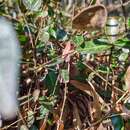mk
имиња во трошки


Libythea lepita, the common beak, is a butterfly that belongs to the Libytheinae group of the brush-footed butterflies family. It is found from southern India to Japan and its larval food plants include members of the Cannabaceae, particularly in the genera Celtis and Trema.[1]
The species was earlier considered a race of Libythea celtis, the European beak.[2] The following description is based on the older treatment and the race lepita and lepitoides described below refer to this species.[3]
Race lepita ranges from the Himalayas (Shimla and Sikkim to Assam) to Upper Myanmar, China and Japan. It differs from the European beak Libythea celtis as follows:
Race lepitoides ranges from southern India to Sri Lanka, and differs from lepita as follows:
Race lepitoides is now considered as a sub-species of Libythea laius.[4]
Libythea lepita, the common beak, is a butterfly that belongs to the Libytheinae group of the brush-footed butterflies family. It is found from southern India to Japan and its larval food plants include members of the Cannabaceae, particularly in the genera Celtis and Trema.
Libythea lepita is een vlinder uit de familie Nymphalidae, de vossen, parelmoervlinders en weerschijnvlinders. De soort komt voor in India, Pakistan en aangrenzend daaraan tot China, Japan en Korea. De soort overwintert als imago.
De soort lijkt sterk op de snuitvlinder en werd lange tijd als ondersoort van die soort beschouwd. Een recente publicatie heeft echter zijn status als soort bevestigd.
Voorheen werd de soort gezien als ondersoort van Libythea celtis, maar in een recente publicatie is de status als soort bevestigd.[1]
Libythea lepita is een vlinder uit de familie Nymphalidae, de vossen, parelmoervlinders en weerschijnvlinders. De soort komt voor in India, Pakistan en aangrenzend daaraan tot China, Japan en Korea. De soort overwintert als imago.
De soort lijkt sterk op de snuitvlinder en werd lange tijd als ondersoort van die soort beschouwd. Een recente publicatie heeft echter zijn status als soort bevestigd.
Voorheen werd de soort gezien als ondersoort van Libythea celtis, maar in een recente publicatie is de status als soort bevestigd.
Носатка лепита[1] (лат. Libythea lepita) — бабочка из рода носаток семейства нимфалид.
Длина переднего крыла 17—27 мм. Усики с постепенным утолщением. Крылья сверху коричневые или коричнево-бурые с крупными охристыми пятнами в центральной части. Переднее крыло сверху с двумя небольшими белыми пятнами у вершины. Заднее крыло без охристого пятна между жилками Rs и М1[1]. Испод крыльев буровато-серый или пепельно-серый с тёмной тенью от корня крыла к его наружному краю, со сложенными крыльями бабочка напоминает сухой лист.
Длительное время таксон рассматривался в качестве подвида Носатки листовидной (Libythea celtis). Однако, эти виды отчетливо различаются по строению VIII тергита 6рюшка. У Libythea celtis центральные лопасти на заднем крае этого тергита имеют треугольную форму, их внутренний край прямой, а выемка между ними имеет форму равностороннего треугольника. Боковые лопасти на заднем крае VIII тергита очень короткие, более, чем в 4 раза короче центральных. Вершинный зубец вальвы у Libythea celtis изогнут только кверху, не S-образно, как у Libythea lepita[1].
Япония, полуостров Корея, Северный Китай, Пакистан, Индия, Индокитай[1].
Населяет поросшие кустарником редины и широколиственные леса. Встречается также на лесных дорогах, балках, на полянах, опушках[1][2].
Вид развивается за год в одном поколении. Обычно бабочки летают не очень быстро. Садятся на ветки со сложенными крыльями и прикладывают к ней плотно сложенные вместе усики и щупики, становясь очень похожими сухой лист. Часто в солнечную погоду бабочки присаживаются на влажную почву или прогретые участки дорог. В жаркие дни часть бабочек забирается в укрытия. Летом бабочки летают довольно высоко в кронах деревьев, редко спускаясь ниже высоты двух метров. Самцы занимают отдельные деревья каркаса и поджидают на них самок.
Самки откладывают яйца по одному в пазухи вегетативных листовых почек. Гусеницы питаются на листьях кормового растения. Потревоженные гусеницы спускаются на 2—3 метра вниз с дерева на шелковинке. Окукливаются на нижней поверхности листьев. Гусеницы питаются листьями каркаса[1].